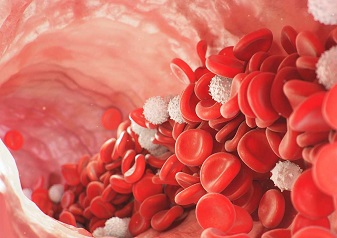More Cases Of Hemophagocytic Lymphohistiocytosis, A Hematological Disorder Emerging As A Complication In Long COVID.
Long COVID - Hemophagocytic Lymphohistiocytosis May 05, 2023 1 year, 11 months, 2 weeks, 1 day, 54 minutes ago
Long COVID: Researchers from Yale University, USA while presenting a new clinical cases report are warning that more cases of Hemophagocytic Lymphohistiocytosis, a hematological disorder are emerging as a complication in Long COVID.

Hemophagocytic lymphohistiocytosis (HLH) is a potentially fatal condition in which certain white blood cells (histiocytes and lymphocytes) build up in and damage organs, including the bone marrow, liver, and spleen, and destroy other blood cells.
The deadly wave of COVID-19, caused by the SARS-CoV-2 virus, has left its mark worldwide, not just through immediate fatalities but also in its puzzling long-term effects commonly pooled as
Long COVID.
Among the myriad of complications, one that stands out is the emergence of Hemophagocytic Lymphohistiocytosis (HLH), a previously lesser-known hematological disorder.
As the world begins to decipher the mysteries of post-COVID conditions, HLH has surfaced as an unexpected result of the pandemic.
HLH, a condition arising from an uncontrollable immune system response, often leads to multiorgan system failure. The devious nature of this illness makes it highly elusive, often going unnoticed until it has caused severe damage. While it can be traced back to various infectious origins, particularly viral, its association with COVID-19 brings a new level of concern.
Picture a man in his mid-sixties, a recent survivor of COVID-19, now grappling with a four-day bout of high fevers and a persistent dry cough. Upon admission to the emergency department, he presents symptoms that seem unrelated, ranging from an increased heart and breathing rate to a drop in oxygen levels. His labs show abnormalities in several areas, including reduced platelet count, kidney dysfunction, and liver damage. Despite his recent victory over COVID-19, he finds himself fighting another battle, this time against an unseen enemy within.
As days turn into a week, his condition worsens. Oxygen supplementation escalates, and high-grade fevers persist. His cough becomes productive, yielding blood-tinged sputum, while an X-ray reveals a developing mass-like opacity in his right lung. Despite escalating care and broad-spectrum antibiotics, his multiorgan system dysfunction deteriorates, hinting at a more sinister affliction.
The hospital team initiates a thorough investigation, but infectious diseases, autoimmune disorders, and other common suspects are ruled out. Amid this diagnostic enigma, they consider the possibility of HLH. A bone marrow biopsy confirms their suspicion: signs of hemophagocytosis, a key feature of HLH, are present. With no evidence of malignancy and the man’s recent COVID-19 infection, the puzzle pieces begin to fit together.
This was an actual true case study of HLH triggered by a post-COVID-19 immune response presented by the team from Yale University.
Understanding HLH requires delving into the complex world of our immune system. The human defense mechanism includes an array of cells such as cytotoxic T cells, macrophages, and natural killer cells that function as warriors, defending against foreign invaders. In HLH, these soldiers turn on their own, lead
ing to a generalized inflammatory response that triggers widespread cytokine release, culminating in self-destruction of multiple organs.
Identifying HLH in its early stages is challenging, as its symptoms often mirror those of sepsis. Like a spy infiltrating an enemy camp, HLH camouflages itself as a simple systemic infection, making early detection difficult. Only when it starts causing systemic havoc does its true identity get unveiled, often too late to prevent substantial damage.
HLH can be categorized into primary and secondary types. Primary HLH, often seen in children, results from genetic mutations causing immune cell dysfunction. Secondary HLH, more common in adults, is triggered by external factors like infections, autoimmune conditions, or malignancies. The emergence of post-COVID-19 HLH, as in this case, falls into this secondary category.
HLH often presents with non-specific symptoms, which can make it challenging for clinicians to diagnose. It can mimic sepsis, a life-threatening condition caused by the body's response to an infection. This case report underscores the importance of maintaining a high index of suspicion for HLH in patients with no clear cause for multi-organ disease, especially those with a history of COVID-19 infection.
In conclusion, COVID-19 has been associated with Long-COVID syndrome, and HLH may be one of the complications that can arise from a history of prior COVID-19 infections. This case report serves as a cautionary tale to the global medical community and stresses the need for vigilance in the face of seemingly unexplained clinical deterioration in post-COVID patients. It is a stark reminder that, while the acute phase of COVID-19 may have passed, there is still the issue of varied Long COVID complications and manifestations to deal with.
The case report was published in the journal: Cureus.
https://www.cureus.com/articles/137453-coronavirus-does-it-again-post-covid-19-hemophagocytic-lymphohistiocytosis-hlh#!/
Other reports of Hemophagocytic lymphohistiocytosis (HLH) emerging as Long COVID complication are as follows:
https://bmcinfectdis.biomedcentral.com/articles/10.1186/s12879-021-06532-7
https://www.jidc.org/index.php/journal/article/view/34898486
https://clinmedjournals.org/articles/ijbrd/international-journal-of-blood-research-and-disorders-ijbrd-9-078.php?jid=ijbrd
https://link.springer.com/article/10.1007/s13730-023-00776-9
https://www.jidc.org/index.php/journal/article/view/37023430
https://jahjournal.org/article.asp?issn=1658-5127;year=2021;volume=12;issue=4;spage=227;epage=231;aulast=Hammami;type=3
For the latest on
Long COVID, keep on logging to Thailand Medical News.
